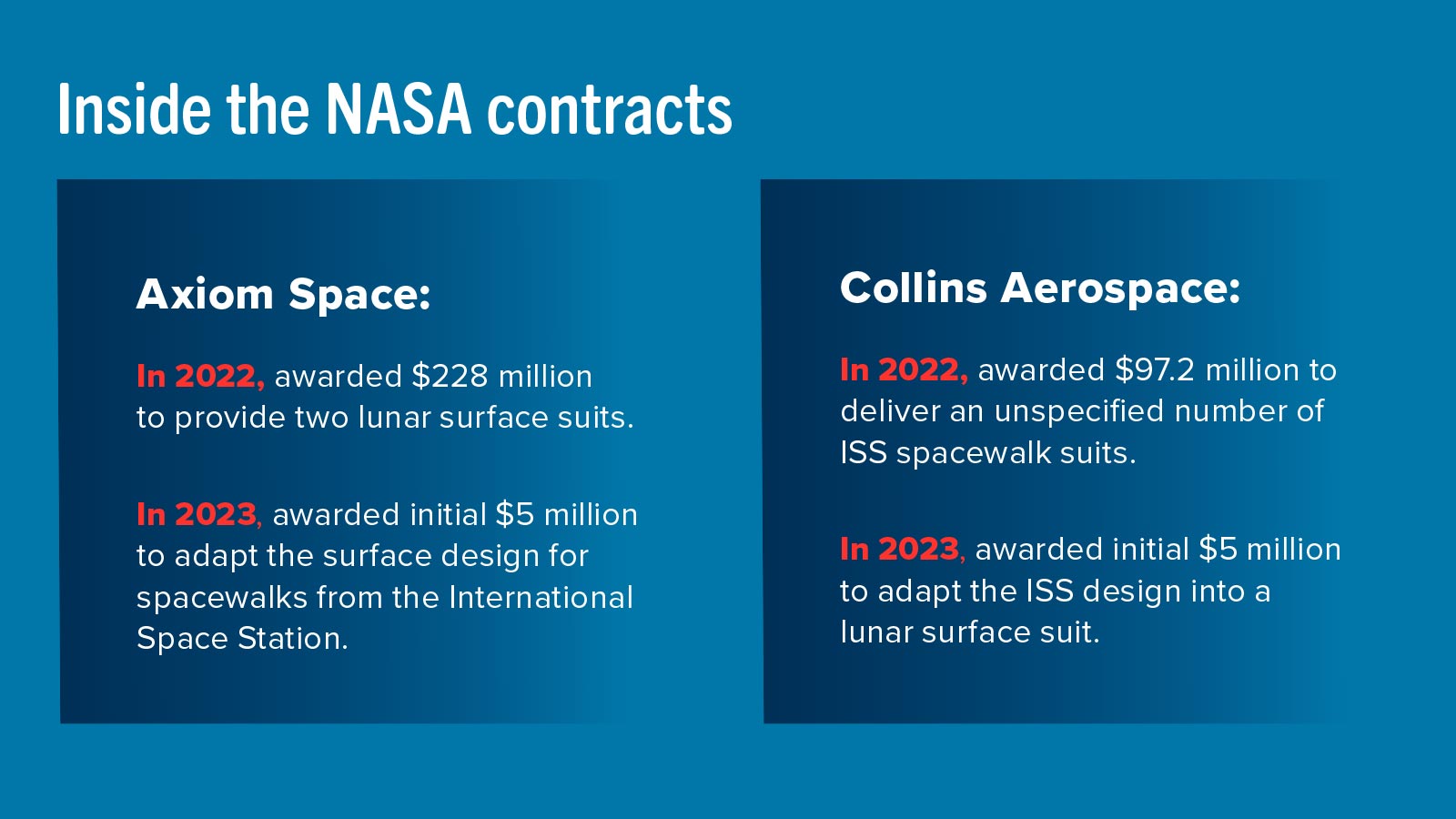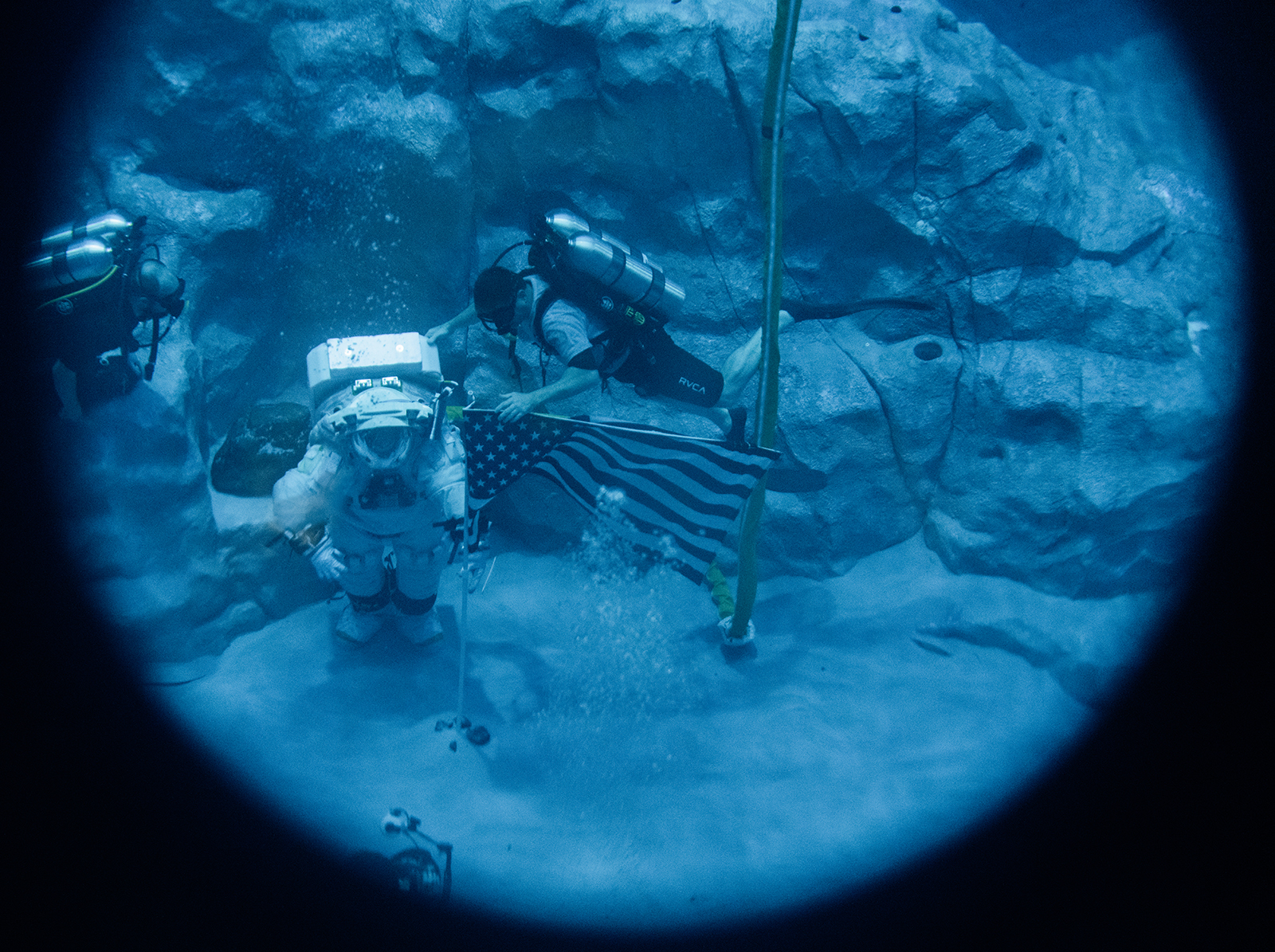Stay Up to Date
Submit your email address to receive the latest industry and Aerospace America news.
The zest to open space to you and me means that the next generation of spacesuits might not be worn by only the usual clientele of professional astronauts. That possibility is inspiring some innovations. Cat Hofacker spoke to the designers.
One of the changes NASA made when the Apollo era closed and the space shuttle era began had to do with spacesuits. Instead of ordering tailor-made, one-piece soft suits, components were made to NASA’s specifications in multiple sizes for astronauts to mix and match, a decision made to manage the cost of outfitting upwards of 100 astronauts of varying heights and weights. Another shift was toward a rigid fiberglass torso that, among other purposes, would shield wearers from possible debris impacts as they conducted extravehicular activities, EVAs, from the International Space Station.
The postponement of one such spacewalk in 2019 illustrated one limitation with these current suits. Plans had called for Christina Koch (pronounced “cook”) and U.S. Army Col. Anne McClain to replace the lithium-ion batteries that store power gathered by the station’s solar arrays with new ones. But once aboard, McClain conducted a spacewalk with Nick Hague and discovered that a size large torso wouldn’t work for her, despite having practiced on the ground with that size. She needed a medium, but there was only one of those aboard, and Koch needed it. Hague ended up working with Koch to replace the batteries. The first all-female spacewalk came seven months later, by Koch and Jessica Meir, when another medium was ferried up.
Then there’s the question of mobility. Let’s say that during a spacewalk, an astronaut wants to touch the chest-mounted display to check the pressure levels of the suit. Doing so would require stretching out the arm to rotate the shoulder bearing, then swinging the arm back toward the chest. Such drawbacks aren’t going to work for the commercial marketplace that NASA aspires to seed in low-Earth orbit, in which suit builders would also rent or sell their suits to private interests. Researchers from various walks of life might want to venture outside privately run stations to tend experiments, or private citizens might pay to spend a week in orbit conducting spacewalks mainly for the coolness of it. These people are likely to have a wider range of body types than professional astronauts, who have often come from the military services or other physically and psychologically demanding backgrounds. McClain is an Army helicopter pilot who flew 800 hours in combat during the post-Sept. 11 Iraq war. Koch, meanwhile, spent a year at the South Pole as a researcher and a member of the firefighting and search and rescue teams.
There is also the age of the spacewalk suits to consider: At 43 years old, they are long past their original estimated operating life. As for surface suits, the Apollo versions are now museum items, so new ones will be needed for the return to the moon in the Artemis III mission, targeted for 2026, which is to include the first woman to walk on the lunar surface.
If the next-generation spacewalk and lunar suits are designed to fit a larger percentage of the population, “you get more people involved who can apply their skills,” says Tom Jones, a retired astronaut who conducted three spacewalks from the space shuttle Atlantis in 2001. “So let’s make full use of the talent pool.”

As for the acquisition strategy, that too has changed dramatically over the decades as NASA shifted from tailor-made suits in the ’60s and ’70s to the mix-and-match suits in the ’80s. Now comes what might be its boldest shift yet: This time, NASA set broader requirements, allowing contractors more leeway in the design so long as the suits are proven safe via tests in some kind of “spacelike environment.” NASA also will rent the suits instead of owning them.
The strategy began to unfold in 2022, when Axiom Space of Houston received a $228 million contract to provide the two Artemis III surface suits and Collins Aerospace, the EVA incumbent, $97.2 million to make new spacewalk suits. A twist came last year, when NASA exercised the “crossover” option in each contract, paying Axiom an additional fee to adapt the lunar suit for EVAs, and the same to Collins to create a surface variant. It’s a two-provider model reminiscent of the strategy behind the agency’s Commercial Crew program, in which NASA funded Boeing to help it design and test its Starliner capsules and SpaceX to do the same with its Crew Dragons. The thinking was that if one provider ran into technical trouble, the other would be ready to ensure NASA has a U.S.-built spacecraft available to ferry astronauts to and from ISS.
Speaking of SpaceX, it has developed its own EVA suit without NASA dollars and could scoop everyone this year by conducting the first commercial spacewalk: a two-person tethered jaunt from a Crew Dragon during the planned Polaris Dawn mission beyond the orbit of ISS. SpaceX has yet to announce the date.
Here are the major design considerations:
Appearance
Line up the prototypes of the Axiom, Collins and SpaceX EVA suits that each company is testing side by side, and your first thought would likely be that the Axiom and Collins suits look very similar.
That’s in large part because both companies are aiming for “a single-suit configuration” — as Axiom’s Russell Ralston put it when we spoke on the sidelines of the Space Symposium in April — meaning a design that needs just a few modifications to go from LEO to the lunar surface and vice versa.
“Now I can train the crew with a single suit design,” whether they’re preparing for an EVA from ISS or a lunar landing, says Ralston, the company’s vice president of Extravehicular Activity and a former spacesuit engineer at NASA’s Johnson Space Center in Texas. “That saves time, and you don’t have to worry about people making mental mistakes cause they think they’re in one suit when they’re in another suit.”
Both suits are to have a white, puffy exterior — the better to keep astronauts cool by reflecting sunlight. Axiom also has a version with a dark blue and black exterior, but the company tells me that is only for display purposes. Both suits are also to include tried-and-true elements that go back to the Apollo design: the bubble-shaped helmets, rubber-tipped gloves and large life support “backpacks” that house the astronauts’ breathing equipment. The Apollo and ISS suits recirculate oxygen via vent ducts, removing carbon dioxide as needed with canisters of lithium hydroxide cells. Should something go amiss, small tanks of oxygen in the backpack provide a backup supply long enough for astronauts to return to their lunar module or get back inside the station.
For Collins, this continuity was part of a deliberate strategy to keep as much of the current EVA design as possible, only making upgrades to improve astronaut mobility or where new and better technology is available.
“We have basically been taking all the lessons learned in the entirety of the spacewalking program and rolling those up into what we currently have as a next-generation spacesuit,” says Danny Olivas, the chief test astronaut for Collins, who completed five spacewalks in the NASA astronaut corps between 2007 and 2009. We spoke in the Space Symposium exhibition hall near a floor model of the suit, though he cautioned me that it’s not a completely accurate representation of the prototype that Collins has been testing for several months.

By contrast, the white and black SpaceX suit appears more fitted — only slightly more voluminous than the Teflon suits that astronauts don for riding inside Crew Dragon capsules to and from ISS. Given the limited room inside Dragon, the choice was made to adapt that intravehicular, or IVA, design into a suit that the four Polaris Dawn crew members would wear during ascent and landing as well as for the spacewalk, SpaceX said last month when it revealed the design. Plans call for billionaire Jared Isaacman, a retired U.S. Air Force pilot, and two SpaceX employees to ride in a Crew Dragon out to the Van Allen Radiation Belt to study the effects of radiation on human health. Isaacman and another crew member would conduct the history-making spacewalk, exiting through Dragon’s nose hatch for a two-hour excursion at an altitude of 700 kilometers. Information about the pressure, temperature and humidity levels of the suits will be viewed via new heads-up displays inside the copper-coated visor. Dragon will remain open to the vacuum of space the entire time, so the two Polaris Dawn members remaining inside the capsule must also don their suits.
“Aesthetically, it may look similar to the IVA” design, Isaacman said during a May livestream, referring to the ascent suit, “but what they did under the hood is extraordinary, and they did it in two years.”
Among the changes, SpaceX says the outer layer of the EVA suit is comprised of a “new textile-based” material interspersed with joints “to provide greater flexibility to astronauts in pressurized scenarios while retaining comfort for unpressurized scenarios.”
In another glaring difference to the Axiom and Collins designs, SpaceX eschewed a bulky life support backpack in favor of an umbilical cord. Like the safety tethers that ensure astronauts do not float away from ISS during today’s spacewalks, these umbilicals are to keep Isaacman and his crew member connected to Dragon. But they will also serve a greater role: Based on illustrations that the Polaris Program has released, this tether would plug into some kind of shoe-box-sized component on an astronaut’s hip to provide life support, an approach reminiscent of the spacewalks conducted during the NASA Skylab program.
“That’s the simplest way” to conduct an EVA, says Jones, the retired astronaut. “You just plug [the tether] into the ship’s life support system and give your guy a 25-foot tether, and out he goes with an umbilical that supplies oxygen and communications and power and gives you the safety tether function built in too.”
Despite the relative ease, this approach might not be ideal for the lunar suits in particular, as it would limit how far astronauts could travel from their landers.
Suiting up
Perhaps the biggest distinction between the three designs centers on how astronauts will put them on and take them off.
SpaceX and Collins made minimal changes from their previous designs. For its EVA suit, SpaceX kept the zipper entry from its ascent suit, but instead of a single zipper running along the inside of the legs, the EVA suit has spiral zippers at the waist, according to the SpaceX website. There are additional zippers at the forearms in the event the Polaris Dawn flyers want to remove their gloves for brief periods while inside the capsule — shortly after ascent to complete some quick task, for instance.
By contrast, the Collins suit is a waist entry, but with some additional steps: An astronaut steps into the legs like one would a pair of pants, then pulls on the upper torso similar to a shirt. The two pieces are connected by a large metal ring designed as a bearing, so the upper and lower parts turn with the wearer. For the upper body, Collins updated the rigid upper torso of the current ISS suit to an adjustable hybrid torso with “soft goods and joints” down the arms, Olivas says.

For its lunar suit, Axiom chose yet a third method of entry. Instead of the zippers on the Apollo suit, Artemis III astronauts will don their Axiom suits through the rear, via a hatch on the side of the life support systems backpack — similar to the door of a front-loading washing machine. After swinging open the hatch, an astronaut inserts feet, then arms, “and you just kind of fall into it,” Ralston says. Axiom chose a design without a rigid frame, believing this would reduce the chance of astronauts injuring themselves if they contorted their bodies while putting on the suits.
That soft outer pressure garment — made of a material that Axiom is not disclosing — is interspersed with joints at the shoulders, elbows, hips and knees. “We’ve done a lot of testing to iterate the types of basic joints that we use and how we pattern the different soft goods to enable flexibility, like bending your elbow or bending your arm,” Ralston says.
Sizing and mobility
Those two considerations go hand-in-hand. “It’s not just about what’s your range of motion,” Ralston says. “It’s about how hard is it” to move. “How much force do you have to exert to use that range of motion?”
An ill-fitting suit requires an astronaut to put more force into a movement, and that in turn means getting tired more quickly.
For Polaris Dawn, the SpaceX suits have been custom-made for each crew member. However, the SpaceX website notes that “building a base on the Moon and a city on Mars” will require manufacturing “millions” of suits, and that the company will be able to “produce and scale” the EVA suit “to different body types.”
By contrast, Axiom and Collins are taking their cues from the shuttle program’s modular approach of manufacturing arms, legs, gloves and boots in multiple sizes. Collins also plans to produce two sizes of the hybrid upper torso that Olivas says “can be adjusted,” though he did not specify how.
“It’s almost like when you go in to get a bespoke suit,” Ralston says. “We’ll have people come in and take [an astronaut’s] measurements, and then we can look at our pantry of spacesuit items and we can assemble a suit for them.”
As for range of motion, Axiom and Collins say that initial testing gives them confidence that their suits will allow astronauts to move easily in LEO and on the lunar surface.
With the Collins suit, Olivas experienced this firsthand earlier this year, when he donned a prototype of the suit and with a handful of Collins engineers boarded an aircraft for two parabolic flights. During dozens of brief moments of weightlessness, Olivas practiced common spacewalking tasks in front of a mock-up of an ISS airlock, which he found “much less of a struggle” than similar movements in the current suit, he says.
For its lunar suit, Axiom has tested the mobility in multiple ways, including late last year at NASA Johnson, when astronaut Victor Glover and Axiom engineers donned prototypes and squatted and knelt in a sandbox to simulate collecting samples on the lunar surface. And in April, an unoccupied suit was lowered into the Neutral Buoyancy Laboratory pool, also at NASA Johnson, with weights added to mimic the lunar gravity that’s one-sixth of Earth’s. Plans call for a human to get inside the suit during future trials, and Collins prototypes are to have their turn in the pool as well.
LEO versus lunar
For Artemis III, Axiom added a few components designed specifically to guard against the harsh conditions of the south pole region, where the crew is to land. In the permanently shadowed regions where sunlight doesn’t reach, temperatures will be as low as minus 230 Celsius (minus 382 degrees Fahrenheit), so the Artemis astronauts will wear boots lined with insulating material. Each astronaut will also have a headlamp on their helmet for visibility, because the angle of the sun throws large shadows across boulders and other large protrusions.

The suit must also hold any tools the astronaut need for any scientific tasks, like scooping up samples of lunar rocks and dirt. Here, Ralston says Axiom and NASA are taking their cues from the Apollo program and “keeping it simple,” at least for the initial Artemis landings.
“It’s amazing how useful a hammer and a chisel is,” he says.
NASA is betting that the lunar landings will also guide planning for its first human mission to Mars, notionally targeted by the agency for the 2040s. Ralston said the company has a good sense of the challenges required for spacesuits for Mars, but he added that the company is “laser focused” on completing the Artemis III suits and adapting that design for LEO spacewalks.
“We’re trying to go as fast as humanly possible,” Ralston says. “If I can make it ready tomorrow, let’s make it ready tomorrow.”
Mars, in fact, is on Olivas’ mind — and he is ready to begin suit development whenever needed.
“I want to be part of that,” he says.
About cat hofacker
Cat helps guide our coverage and keeps production of the print magazine on schedule. She became associate editor in 2021 after two years as our staff reporter. Cat joined us in 2019 after covering the 2018 congressional midterm elections as an intern for USA Today.
Related Posts
Stay Up to Date
Submit your email address to receive the latest industry and Aerospace America news.




